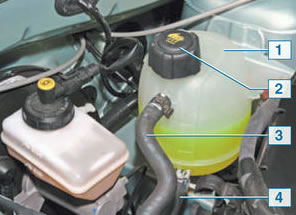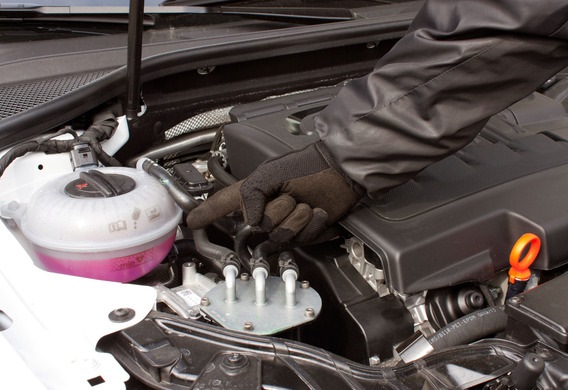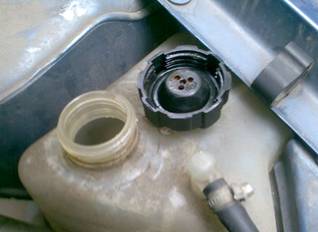Expansion tank- a necessary element of the system liquid cooling. It serves to compensate for the change in volume characteristic of any liquid with a change in temperature. Depending on the design of the system, it can be either a simple reservoir for excess fluid or an element that regulates pressure in the cooling system.
What is an expansion tank for?
The coefficient of thermal expansion of such liquids, which are based on an aqueous solution of propylene glycol or ethylene glycol, is much higher than that of water. If antifreeze or antifreeze is poured into cold radiator“under the neck”, then when the engine is turned on and the thermal expansion of the coolant, its excess appears. Fluid through safety valve is squeezed out of the radiator and enters a primitive expansion tank that serves as a reservoir for excess antifreeze.Propylene glycol, which forms the basis of antifreeze and antifreeze, is the main element of liquid for electronic cigarettes.
When the engine is turned off and cools down, the volume of liquid in the radiator decreases and a vacuum occurs in the cooling system. The radiator cap valve is activated and air is sucked into it. There is a danger of air pockets in the "cooling jackets". This can lead to a disruption in the heat exchange process and overheating of the motor. Therefore, there was a need for an additional reservoir for liquid that would enter the radiator instead of air. The expansion tank has become such a reservoir. There are systems in which bypass valve, which allows the release of excess steam and even excessively hot coolant, is not located in the radiator cap, . In this case, the expansion tank, as it were, performs the function of the upper part of the radiator and is included in the cooling system as an important element.
Location and arrangement of the expansion tank
Expansion tanks are made mainly of transparent plastic. During manufacture, a special shackle is applied to the side wall, which allows you to monitor the level of coolant in the system. The lower mark on the side surface indicates the minimum allowable level liquids. Max Level coolant in the tank with a cold engine should be 25-30 mm above the top mark on the side of the expansion tank.When calculating cooling systems, it is customary to leave approximately 1/20 of the total volume of liquid for thermal expansion. How much antifreeze can fit between Min and Max
The expansion tank is located next to the radiator and is attached directly to the car body. The middle of the tank and the upper edge of the radiator are located on the same level - according to the principle of communicating vessels. Using a hose located at the bottom of the expansion tank, it is connected to. This design allows excess heated coolant to enter the tank. And when the engine cools down - to compensate for the volume of liquid in the system from its contents. This process prevents air from entering the radiator.
Typical malfunctions of the expansion tank
The most common breakdowns are rightly considered leakage or rupture of the expansion tank. Leakage may be due to a violation of the integrity of its body or a defect in the connecting hose. A ruptured expansion tank can result in a catastrophic drop in coolant volume. This may cause the engine to overheat. If this happens, it is necessary to urgently stop and, replacing the damaged element, replenish the volume of liquid. It should be remembered that it is strictly forbidden to add cold liquid to the cooling system, as this can lead to the formation of cracks in the block head or in the cylinder block itself.The expansion tank has become a common part of a car from the moment it was actively used antifreeze liquids, including antifreezes and antifreezes, however, given the specifics in which it functions, such a problem as “how to glue the expansion tank” becomes relevant over time.
In order to understand this issue, you should delve a little into the specifics.
So, the basis of the liquids used by the expansion tank is aqueous solutions dihydric alcohol(ethylene glycol), their feature is an increased coefficient determined for thermal expansion (compared to water).
Given this, the liquid poured into the system undergoes expansion during engine warm-up, which leads to its extrusion out through the safety valve located in the radiator cap.
When the engine is turned off, which begins to gradually cool down, the volume of liquid decreases, which leads to a vacuum in the cooling system.
Naturally, in this case, the cover valve is activated, which leads to air being sucked into the radiator, this leads to a violation in the process of heat removal, and everyone knows what danger overheating is.
In order to get inside not air, but liquid, an additional reservoir is required, which, in fact, is the expansion tank.
It, through the use of a hose, was connected directly to filler neck in the radiator, positioning it so that the middle approximately coincides with the level of the upper edge of the radiator.
This design squeezes the excess of heated fluid into the tank, in the process of cooling the engine, it refills the system with itself, while air ingress is excluded.
By the way, due to the installation of an expansion tank, the problem associated with environmental pollution was also solved at the same time.
Returning now directly to our question of how to seal the expansion tank, it can be noted that only its replacement will save the situation.
This is explained by the fact that not a single glue is able to withstand the pressure exerted by a liquid brought to a temperature of a hundred degrees.
In addition, some car models keep the operating temperature exactly within the specified temperature, or even higher.
Accordingly, for antifreeze and antifreeze, the boiling point is determined at almost 103 ° C, while due to the tightness that characterizes the cooling system as a whole, in the process of increasing pressure in it, the liquid may not boil even at 115 ° C.
Given this, if there is a crack, then the liquid will not only begin to flow out, but also, due to depressurization, its boiling point will drop significantly.
Radiator and expansion tank repair

In this article I want to tell you what to do if a radiator or expansion tank is leaking. First you need to understand why this happened. Almost all cooling systems have pressure, it can be up to 2 atmospheres, depending on the brand of car. Excessive pressure should be relieved by the cap of the expansion tank (or radiator). If the lid is soured, then the pressure begins to rise, as a result of which the plastic cracks. and sometimes honeycombs in the radiator. In newer car models, it is almost impossible to check the expansion tank cap. the valve itself is rolled in a plastic case, and not every car service can find a special pressure gauge for checking pressure in cooling systems. Therefore, if the expansion tank (or radiator) cracked by itself (without mechanical impact) the first thing I advise is to replace the cover. It costs around $ 5, although there are not very cheap exceptions.
Now about the repair itself. The plastics from which expansion tanks and radiators are made do not react with more than one glue, so it will not be possible to glue them with high quality. If you need to eliminate the leak for a while, you can clean the crack with sandpaper, degrease it with a solvent and fill it with poxypol or close it with cold welding. If everything is done qualitatively enough for several months. The whole problem is that the plastic in the cooling system, due to temperature differences, narrows and expands. Therefore, no matter how well you glued it over time, it will still flow.
The most reliable, in my opinion, the only way to repair plastic in the cooling system is welding. Almost all expansion tanks are made of PP polypropylene or PE polyethylene. They cook very well, in my practice, not one has not dripped after repair. As a donor, it is better to take not a bumper, but something more rigid, such as fender liner. It is more difficult with radiators, they are made from pa66. It is one of the hardest and most refractory plastics. The repair of such plastic must be approached very carefully, otherwise it will have to be redone. Below there will be a video of repairing an expansion tank from pa66, these are very rare and do not differ from radiators in the complexity of the repair. As a donor, I took the case from a broken drill.
Highlights a large number of heat. At the same time, it is important to keep the temperature of the unit within the specified limits for the most efficient combustion of fuel, reducing the level of exhaust toxicity, increasing the resource, etc.
In other words, it is impossible to cool the motor as much as to allow it to overheat. To maintain the required operating temperature in the device modern engines used combined system which combines liquid and air cooling.
In the device of the liquid cooling system important element is the expansion tank. Next, we'll talk about what an expansion tank is for, what is its main purpose, and also what malfunctions of the expansion tank of the engine cooling system are most common.
What is the purpose of and where is the expansion tank of the engine cooling system
So, it is enough to open the hood to find the indicated tank. Usually, given element always in sight so that the driver can easily control the coolant level, as well as top up if necessary. On different cars tank can be mounted to the left or right of power unit, closer to the motor shield or farther from it.
The main function of the tank is to compensate for the changing coolant volume. This effect occurs as a result of a change in the temperature of the liquid. The device of the cooling system may differ, in some cases the tank is a simple container for excess liquid, while in others it is a whole device capable of regulating the pressure in the system.
Expansion tank needed liquid system on modern internal combustion engines. The fact is that coolants (antifreeze, antifreeze) are aqueous solution based on ethylene or propylene glycol. Such a liquid has a higher coefficient of thermal expansion compared to water.
Simply put, by pouring such a liquid into the radiator, after heating the internal combustion engine and reaching operating temperatures, the liquid will also heat up and expand. It turns out that surpluses are actually formed, there is an increase in pressure, etc.
If you turn off the engine, after the coolant cools down, the volume of liquid again decreases, and a vacuum is created in the system. This leads to the fact that through the valve in the radiator cap is sucked outdoor air. It is quite obvious that in this case air locks will be created, which will cause heat transfer disruption, incorrect operation of the cooling system, etc.
In order to prevent this from happening, a separate container (cooling system tank) is installed, where excess hot coolant from the radiator gets. Also, the presence of liquid in the tank avoids the creation of vacuum and the formation of air pockets, since when the volume decreases as a result of cooling, the liquid from the tank fills the voids.
Today, designers have gone even further by moving the bypass valve that used to be in the radiator cap to the expansion tank cap. It turns out that the release of pressure and excess antifreeze during boiling occurs through the tank lid. In other words, the tank took over the function of the top of the radiator and ceased to be a simple reservoir.
As mentioned above, the tank can be installed in different places V engine compartment, however, the place of its installation must be realized in such a way as to achieve the effect of communicating vessels. The tank and the radiator are connected by pipes.
This solution allows access for excess hot antifreeze to the expansion tank. When the coolant cools, it is also possible to compensate for the missing volume in the system by receiving fluid from the tank. This scheme eliminates the ingress of air into the radiator and the formation of air pockets in the system.
Expansion tank device

Structurally, this container is very simple. The material of manufacture is translucent plastic. Also, a sensor can be additionally built into the tank, which signals the driver about a critical decrease in the coolant level.
On top of the tank is closed with a lid, in which a valve is installed to regulate the pressure. If the pressure in the system rises, then the valve is activated.
Also on the wall of the tank there is a level indicator in the form of "minimum" and "maximum" marks, allowing you to control the liquid level. It is important to understand that on a cold engine, the level should not fall below the minimum. It is also not allowed to exceed the maximum level.
As for the tank lid with valve, it is on cold ICE seals the container. However, when the engine reaches operating temperature and the coolant heats up, the pressure naturally rises in the cooling system and in the tank.
If the pressure rise reaches an average of 120 kPa, the valve opens. When the pressure drops to an average of about 83.4 kPa, the valve closes. Such valve operation is necessary in order to avoid rupture of pipes, damage to the radiator, etc.
In parallel with this, after the engine cools down, the pressure in the system begins to drop, the coolant volume decreases and a vacuum is created. When the pressure drops, on average, below the mark of 3 kPa, the inlet valve of the expansion tank opens to take in air. As a result, the pressure difference is leveled, and the missing volume of liquid is compensated from the tank.
Common faults

As a rule, most problems are not related to the capacity itself. Not so often there are cases when the tank itself cracks and starts to flow for no apparent reason. However, even taking into account the simple design, the cap of the expansion tank of the engine cooling system may well be the problematic part.
The valve built into the cover may fail. Also, insufficient sealing can occur due to deformation of the rubber ring. As a result of such malfunctions, the cover may begin to leak antifreeze, the system becomes airy, etc.
If the valve in the cap starts to work incorrectly, then in such a case inevitable deviations in the operation of the system internal combustion engine cooling. In addition to the formation of air pockets, this situation in some cases leads to a critical increase in pressure and rupture of the expansion tank. IN similar situation tank needs to be replaced with a new one. It is not recommended to attempt to restore a damaged container by soldering cracks.
If we talk about the cover, its damage and defects, as well as malfunctions of the valves due to clogging or exhaustion, are the reason for replacing the cover. In some cases, the cover is cleaned in an attempt to restore functionality, but this method does not always work. Given the low cost, it is better to replace the element immediately.
What is the result
As you can see, the device modern car to the engine cooling system and its correct operation increased demands are made. For this reason, a special tank is additionally used in the design for effective functioning.
You also need to know if the specified expansion tank of the engine cooling system is involved in the circuit, that it is highly desirable to fill the system with only antifreeze or antifreeze, and not water. As for breakdowns, if pressure builds up in the cooling system or air locks form, special attention must be paid to the expansion tank cap.
Violation of the valves in the cover often leads to the fact that the pipes are damaged, the thermostat fails faster, the pump suffers, the engine may overheat, etc.
How much interesting articles written about thermostats, pumps, radiators ... But the expansion tank bothered to pay attention only in passing. But when you are desperately fighting with air locks in winter, to make the stove work in the car, or wonder why the arrow on the engine temperature gauge is desperately approaching the red border or does not reach the working one, do you think about why this happens and what is the reason ... Therefore, today we will talk about what troubles are hidden in the expansion tank, and how to avoid them.
What is an expansion tank
Expansion tank with closed cap This is a plastic container with rubber hoses, with or without a coolant level sensor, and a pressure bypass valve built into the plastic cap. It is with this most insignificant detail at first glance, like a cover with a valve, that we will deal.
Why is she needed at all? And it's all about the coolant (coolant). Engine operating temperature domestic manufacturers, as a rule, is equal to 90-95 C, and so that the coolant does not boil while circulating in the system, its boiling point must be much higher, approximately 130 C. Therefore, coolants are initially created with elevated temperature boiling.
Also very an important factor is to maintain high blood pressure in the engine cooling system (OSD), greater than atmospheric pressure, since pressure is a necessary condition for increasing the boiling point.
Working pressure in OSD domestic cars is, as a rule, 1.0 kgf/cm2, and imported cars– about 1.5 kgf/cm2. Since the efficiency and working temperature engines of imported cars is higher and equals approximately 100-105 C, then the pressure in the system should be greater.
“And what exactly does a cap in an expansion tank have to do with pressure?” - you ask. The most direct...
The principle of operation of the cap of the expansion tank

Expansion tank, Exhaust valve. When the engine heats up, the coolant also heats up. At the same time, since the SOD is absolutely hermetic, excess pressure is created. All SOD begins to expand, and excess air accumulates at its highest point - the expansion tank. Further, under the influence compressed air Expansion tank bleed valve opens and excess air escapes.
When the engine cools down, reverse process. The pressure in the system drops, and in order to avoid decompensation, that is, a decrease in the pressure level in the tank below atmospheric, it opens inlet valve and sucks air into the system.
It often happens that drivers do not pay attention to this small cap special attention. As a result, its gradual clogging and even corrosion occurs. The valve stops working properly.
Consequences incorrect operation expansion tank cap valves

If the valve in the tank has rusted and crumbled, then the tightness of the entire SOD is broken. Excess air begins to freely enter and exit the system, forming air pockets. Which, in turn, provoke overheating of the engine, depressurization of the SOD, failure of its parts and a non-working stove in winter.
If the valve is clogged, it will also not function. This leads to the formation of excess pressure, and, as often happens, depressurization of the SOD. When it is completely depressurized, it breaks off the pipes, which is fraught with boiling of the engine. With partial - radiators flow, seals flow, pipe clamps loosen, the thermostat fails and less often the pump, etc.
The correct operation of the valve can be checked very simply. First, after examining it, and if you don’t notice any dirt and rust, then just press it with your finger. When the internal plastic valve is in good condition, you will hear a sucking sound when the valve is released and a hissing sound of air escaping when pressed when you hold the cap to your ear.
So, from all of the above, we want to draw a conclusion. As folk wisdom says: "The spool is small, but expensive." Do not neglect such a small but very significant detail as the cover of the expansion tank of the engine cooling system. Periodically looking under it, you will be able to avoid many subsequent problems. Good luck on the road!
How many interesting articles have been written about thermostats, pumps, radiators ... But the expansion tank bothered to pay attention only in passing. But when you are desperately fighting air congestion in the winter to get the stove working in the car, or wondering why the arrow on the engine temperature gauge is desperately approaching the red border, do you think about why this happens and what is the reason ... Therefore today we will talk about what troubles are hidden in the expansion tank, and how to avoid them.
What is an expansion tank
This is a plastic container with rubber hoses, with or without a coolant level sensor, and a pressure bypass valve built into the plastic cover. It is with this most insignificant detail at first glance, like a cover with a valve, that we will deal.
Why is she needed at all? And it's all about the coolant (coolant). The operating temperature of engines of domestic manufacturers, as a rule, is 90-95 C, and in order for the coolant not to boil while circulating in the system, its boiling point must be much higher, about 130 C. Therefore, coolants are initially created with an increased boiling point.
It is also a very important factor to maintain an increased pressure in the engine cooling system (OSD), which is greater than atmospheric pressure, since pressure is a necessary condition for increasing the boiling point.
The operating pressure in the OSD of domestic cars is, as a rule, 1.0 kgf / cm2, and of imported cars - about 1.5 kgf / cm2. Since the efficiency and operating temperature of imported car engines are higher and equal to approximately 100-105 C, then the pressure in the system should be greater.
“And what exactly does a cap in an expansion tank have to do with pressure?” - you ask. The most direct...
The principle of operation of the cap of the expansion tank
 When the engine heats up, the coolant also heats up. At the same time, since the SOD is absolutely hermetic, excess pressure is created. All SOD begins to expand, and excess air accumulates at its highest point - the expansion tank. Further, under the influence of compressed air, the outlet valve of the expansion tank opens, and excess air escapes.
When the engine heats up, the coolant also heats up. At the same time, since the SOD is absolutely hermetic, excess pressure is created. All SOD begins to expand, and excess air accumulates at its highest point - the expansion tank. Further, under the influence of compressed air, the outlet valve of the expansion tank opens, and excess air escapes.
When the engine cools down, the process is reversed. The pressure in the system drops, and in order to avoid decompensation, that is, a decrease in the pressure level in the tank below atmospheric pressure, the inlet valve opens and sucks air into the system.







